Digital Signage: Everything Old Is New Again
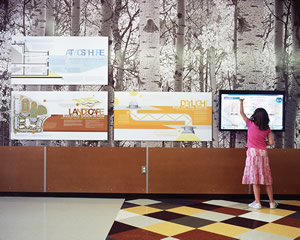
PHOTO COURTESY OF DLR GROUP
Once upon a time there was digital signage in K-12 schools. It was successfully used for many things. As a bonus, eliminating bulletin boards and posters meant hallways were de-cluttered. Then, as they always do, things changed. And suddenly, digital signage does so much more.
Before beginning that story, let’s talk about the value that digital signage adds to creating a safe and secure environment because, if nothing else, administrators desire safety and security. First, it can provide a valuable secondary layer of emergency communication while also providing a primary source of emergency information for persons with special needs. “Second, electronic signage can be extremely helpful in enhancing emergency communications in loud spaces such as gymnasiums, pool areas, vocational shops, cafeterias, food preparation areas and other areas where occupants may have difficulty hearing traditional public address systems,” indicates Michael Dorn, executive director of Safe Havens International, Inc., Macon, Ga.
Now, on to the story.
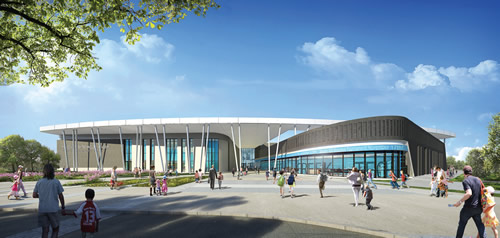
PHOTO COURTESY OF PERKINS+WILL
That Was Then
When digital signage began making its way into schools in the 2000s, administrators were happy to have a tool that let them inform and engage students quickly, easily and effectively. The beauty of digital signage is that it can be located anywhere; multiple messages can be displayed at the same time; and messages can be customized for a specific audience at a specific time, such as information for parents during an open house. Indeed, some of the places and ways digital signage was, and still is, being used include the following, bearing in mind that its use is limited only by your imagination.
- In entryways/hallways, it can display a school map; promote after-school activities; and provide morning and afternoon announcements, safety alerts, emergency announcements, and fundraiser information.
- In classrooms, it can display morning announcements, student recognition, student work, and assignments/due dates.
- In the library, it can display types of materials (such as new releases), rules/regulations and in which area a specific class is meeting.
- In the cafeteria, it can display the day’s menu and nutrition information.
- In the gymnasium, it can announce upcoming theater, band, sporting, and other events.
- In the auditorium, it can display information and announcements related to an assembly at hand, such as “Please turn off all digital devices” or “Scholarship forms are due March 1.”
- In the staff lounge, it can display schedule changes (such as early dismissal), announcements, and reminders.
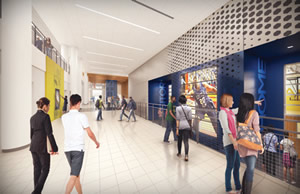
PHOTO COURTESY OF PERKINS+WILL
All this wonderfulness came with a caveat, though, as Todd Ferking, AIA, principal with DLR Group’s Seattle office explains. “Administrators saw digital signage as traditional signage,” he says, “in that it was simple messaging, and it included the implied ‘Don’t touch.’ They didn’t see the collaborative ability, and how it could enhance the environment.”
This Is Now
Today, administrators are thinking about digital signage in terms of collaboration, interactivity, and places for students to drop in and work—making them as multifunctional as possible. “They want students to be able to interact with the digital displays,” observes Ferking. “They’re finding multiple layers of use. For example, in using a digital display as a physical connection point, complete with seating, a student can drop in, override the signage, and share content live in person from that point.” Indeed, in using a 60-inch interactive display system with touchscreen display link capabilities as a collaborative station, where, for example, two students can plug in a lap top and share content, not only is collaboration encouraged, but the environment itself becomes more functional.
And it makes sense from the perspective that students are making multiple decisions about their day and taking in lots of information before they even walk into their schools, not to mention that these digital natives respond well to imagery as opposed to text. “If that’s the way they’re working,” expresses Catherine Dalton, AIA, RID, interior project architect in the Dallas office of Perkins+Will, “why not connect with them at their level? It creates a better sense of community in the school, which matches up with the fact that there’s already a strong sense of community in the digital space.”
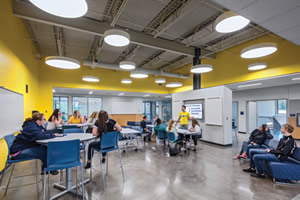
PHOTO COURTESY OF DLR GROUP
Ferking notes that Tahoma High School in Maple Valley, Wa., is a recent digital signage success story in the way the displays are integrated throughout the campus. The 2,400-student school boasts 12 monitors, nine in learning suites and three scattered throughout the learning commons. “It’s a new high school,” he explains, “so everyone is just starting to understand how to use them and gain a comfort level.”
Dalton cites Katherine Johnson Elementary in Dallas, as an example. This new construction project, slated to be complete in summer 2018, is a technology academy. The design includes a massive scrolling ticker that begins on the exterior and weaves its way into the interior, where it will integrate into a large digital wall. “We’re hoping that, because it’s a tech academy, they’ll have a strong commitment to keep up with the display and have a strong prompt for students to use it,” she says.
And, at Little Elm High School in Texas, administrators are going to connect with students by allowing them to post digital content interlaced with branding. “It gets hairy allowing students to post their own content,” admits Dalton. “The people on the bleeding edge have to work through the protocol and interface.” Still, it allows for real time information dissemination in the form of an announcement. It also takes away the step of asking students to visit your website to get information; instead, you’re meeting them where they are to give them the content.
Embracing the Future Today
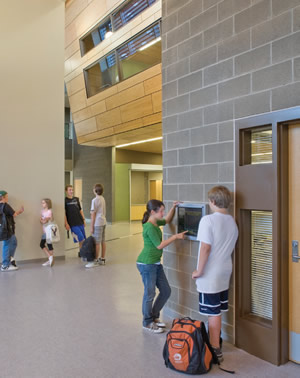
PHOTO COURTESY OF DLR GROUP
When you’re ready to create a flexible, collaborative learning environment with digital signage, expect folks like Ferking and Dalton to guide you through the process. They want to ensure that administrators are using the technology not because it’s the latest and greatest thing since sliced bread, but to ensure it adds value. Specifically, they are going to ask what you want to accomplish, understanding that some administrators aren’t comfortable allowing students to control digital content. “It’s not about monitoring the screen: that’s not adding value,” Dalton explains.
In addition, they’re going to ask about the student culture, to ensure it aligns with the product. They’ll offer to help with a teacher orientation and talking about backend technology with an AV consultant. Finally, they’re going to ask if everyone is on board and, if not, how can they help you accomplish that. For example, they’ll help craft messaging that goes out to specific audiences to help build buy in. “We want to help you succeed,” says Dalton.
Finally, a word of caution. As with other communications systems, it is important for staff who will activate electronic signage in emergencies to practice crafting and selecting messages based on a variety of crisis scenarios. “Affording staff this opportunity reduces the chances that they will make messaging errors under stressful conditions,” Dorn notes.
Today’s digital signage encourages engagement, collaboration and interactivity. It meets students where they are. Are you ready for it?
This article originally appeared in the School Planning & Management January 2018 issue of Spaces4Learning.